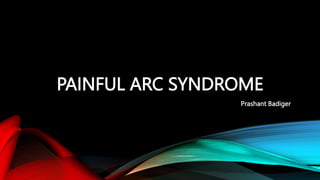
Painful Arc Syndrome.pptx
- 1. PAINFUL ARC SYNDROME Prashant Badiger
- 2. PAINFUL ARC SYNDROME • Shoulder Impingement Syndrome • Supraspinatus Syndrome • Swimmer's Shoulder • Thrower's Shoulder
- 3. PAINFUL ARC SYNDROME • It is a clinical syndrome which occurs when the tendons of the rotator cuff muscles become irritated and inflamed as they pass through the subacromial space.
- 4. PAINFUL ARC SYNDROME • Occurs when one of the rotator cuff tendons (supraspinatus) or bursa is pinched between the humeral head and the undersurface of the acromion. • This happens because as we raise our arm, the narrow space between the humeral head and the acromion naturally compresses. • It is the repetition of such movements that leads to the condition developing, causing swelling and an excess of fluid in the joint.
- 6. PAINFUL ARC SYNDROME • Result of painting, carpentry, construction work or any other jobs that involve overhead work. • Take many years before someone begins to notice the symptoms of the condition.
- 7. CAUSES - BONY STRUCTURES • Subacromial spurs (bony projections from the acromion) • Osteoarthritic spurs on the acromioclavicular joint • Variations in the shape of the acromion.
- 10. CAUSES • Thickening or calcification of the coracoacromial ligament
- 11. CAUSES • Loss of function of the rotator cuff muscles, due to injury or loss of strength, may cause the humerus to move superiorly.
- 12. CAUSES • Inflammation and subsequent thickening of the subacromial bursa may also cause impingement.
- 13. SIGNS AND SYMPTOMS • The most common symptoms are: 1. pain 2. weakness 3. loss of movement at the affected shoulder
- 14. SIGNS AND SYMPTOMS • The pain is often worsened by shoulder overhead movement and may occur at night, especially if the patient is lying on the affected shoulder.
- 15. SIGNS AND SYMPTOMS • The onset of the pain maybe: 1. Acute, due to an injury. 2. Insidious onset, due to a gradual process like an osteoarthritic spur.
- 16. SIGNS AND SYMPTOMS • Other symptoms: • Grinding or popping sensation during movement of the shoulder.
- 17. SIGNS AND SYMPTOMS • The range of motion at the shoulder may be limited by pain. A painful arc of movement may be present during forward elevation of the arm from 60° to 120°.
- 18. SIGNS AND SYMPTOMS • Passive movement at the shoulder will appear painful when a downwards force is applied at the acromion but the pain will ease once the downwards force is removed.
- 19. DIAGNOSIS • By history and physical examination • Neer Test • Hawkins-Kennedy Test • X-ray • Arthrography • Ultrasonography • MRI
- 20. NEER TEST • With the patient seated, the examiner raises the affected arm in forced forward elevation while stabilizing the scapula, causing the greater tuberosity to impinge against the acromion. • Pain Positive test
- 22. HAWKINS-KENNEDY TEST • Elevate the arm to 90 degrees, bend the elbow and force the shoulder into internal rotation, grinding the greater tuberosity under the coraco-acromial arch impinging supraspinatus tendon. • Pain Positive test
- 24. DIAGNOSIS - PLAIN X-RAY • Joint pathology and variations in the bones, • Acromioclavicular arthritis • Variations in the acromion • Calcification
- 25. DIAGNOSIS-MRI • MRI showing subacromial impingement with partial rupture of the supraspinatus tendon.
- 26. TREATMENT 1. Stop any activity that can/may aggravate symptoms 2. Medicate with anti-inflammatory medicine 3. REST 4. Gentle stretching exercises 5. Exercises to STRENGTHEN the rotator cuff 6. If all else fails after 6 to 12 months, arthroscopic or open surgery to repair damage and relieve the pressure on the tendons and bursae
- 27. TREATMENT - CONSERVATIVE • Rest. • Cessation of painful activity. • Physiotherapy focused at maintaining range of movement and avoid shoulder stiffness. • NSAID's and ice packs may be used for pain relief.
- 28. TREATMENT - CONSERVATIVE • Therapeutic injections of corticosteroid and local anesthetic may be used for persistent painful arc syndrome. • The total number of injections is limited to three due to possible side effects from the corticosteroid like tendon damage.
- 29. TREATMENT - SURGERY • Done arthroscopically or as open surgery.
- 30. TREATMENT - SURGERY • The impinging structures may be removed in surgery. • The subacromial space may be widened by resection of the distal clavicle and excision of osteophytes on the under-surface of the acromioclavicular joint. • Also, damaged rotator cuff muscles can be surgically repaired.
- 31. THANK YOU
Notes de l'éditeur
- bursa (a flat, fluid-filled membrane that prevents the shoulder parts from rubbing together)
- The pain is often worsened by shoulder overhead movement and may occur at night, especially if the patient is lying on the affected shoulder.
- Acute, if it is due to an injury Insidious onset if it is due to a gradual process such as an osteoarthritic spur.
- Passive movement at the shoulder will appear painful when a downwards force is applied at the acromion but the pain will ease once the downwards force is removed.
- Stabilise pt. scapula, then pronate, passively forced forward elevation. this pinches rotator cuff muscles under coraco-acromial arch.
- Forward elevation to 90 degrees, bend elbow, internal rotation of humerus This drives greater tuberosity under coraco-acromial arch impinging supraspinatus tendon.
- Physiotherapy focused at maintaining range of movement and avoid shoulder stiffness. The main types of NSAIDs include: ibuprofen. naproxen. diclofenac. celecoxib. mefenamic acid. etoricoxib. indomethacin. high-dose aspirin (low-dose aspirin is not normally considered to be an NSAID)
- 2. Due to possible side effects from the corticosteroid like tendon damage.